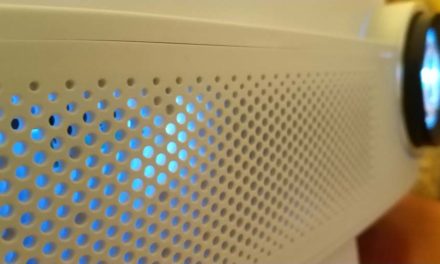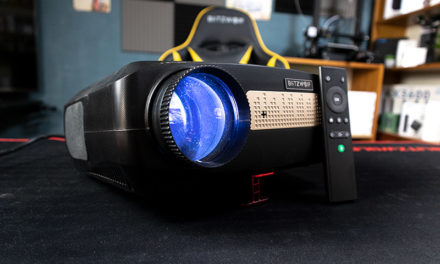
LG AF115 - The Quality Home Cinema Projector
Installing a home theater projector is certainly not a small task, only professionals can get a (close to) perfect result from the devices. In view of the complexity of the operation (series) - but perhaps above all its importance - we dedicate an entire page to the "preparations" - which, of course, have a decisive influence on the final result.

To get a similar result in the end, we will need a lot of time and energy (and of course money)
As a first step, we need to develop one premiseset, which we would call a home theater room. In addition to the fact that this room (or room) certainly has a decisive influence on the image quality, it can basically determine the type of equipment used. What we need to pay attention to first and foremost is the proper darkening. Perhaps this is the most important starting point for home projection. Why is this so important? The darkness in the home theater room - that is, the lack of light - determines how much contrast we will be able to achieve - here we think primarily of the importance of the black level - and of course, last but not least, we can also aim to create the atmosphere.

Applying dark tones is not a matter of chance
If we look at it from this point of view, an ideal location can be said to be a converted basement or cellar, and in the case of a house with a garden, an external storage can also become our target - of course, if it has the right dimensions. In general, we need a minimum of 15 square feet of space to really call our work home (from here, of course, the starry sky is the ceiling). If we have absolutely no other option and we are forced to live up to our desires in this living room, we will certainly be forced to make compromises.

Surely we have to count…
There is no mention of a very important accessory, and this is the canvas. This is (also) a relatively delicate topic, we don't want to be very complicated - we may be interested in the selection from the installation companies. However, we would like to note a few basic things. The first - and of course - theorem is that the size of our screen determines the size of the projected image. But what about aspect ratio? This is a very difficult question as the films are very different in this respect. From a cinematic point of view, the two most important ratios are 16: 9 (1,78: 1) and 21: 9 (2,34: 1), and it is true that Blu-ray releases also typically favor these two, or slightly different, aspect ratios. - although in theory we always encounter 1920 × 1080 video information on the disc (this is how the native 1080p24 drive can be realized).

From what position do we look at our projected image? (THX recommendation)

If we already have the exact size of our room and we know how megalomaniacal we are - that is, from what distance we would like to see the image size (note here that according to the THX standard we can see it on the canvas at a maximum angle of 40 °, but it can be a good starting point for us, if we take twice the width of the image size to determine the viewing distance, of course this can be adjusted within personal limits to take into account personal needs) - then to choose the canvas we also have to decide whether we want to mask vertically or horizontally. Both solutions have their advantages and disadvantages: because it’s easier to get a 16: 9 screen, horizontal masking may seem more tempting at first. However, there are two things in favor of vertical: most films are 21: 9 (or similar), and it is easier to cover up in a home environment - with two side curtains, for example.

The classic solution
There is no mention of the type of canvas yet. The most common is the canvas that can be pre-lined from the case, of which there are basically two types: manual (roller) and motorized. The latter is not so popular in Hungary, as the inclusion of electronics in the work approximately doubles the price - in vain it means much more comfort and increased protection against elongation. For those who want the best in terms of cinema, we would recommend the fixed installation type, as there can be no question of displacement or corrugation or creasing. Of course, this is where the FTF (wife's tolerance factor) comes into play, because the fixed canvas is there on the wall in a permanent way, the easiest way to cover it is with a curtain - it's true, then the problem of masking is a thing of the past.

Like Lake Balaton in the stillness of the wind - nowhere is a wave
Based on the above, the importance of the surface involved in image creation is clear, but let's go back a bit to our built-up room! If we think through what has been described so far logically, we can see: the darkest point of the projected image depends not only on the projector, but also on the "living" canvas in the given room conditions - and maybe primarily on the latter. The color black is nothing more than a lack of light in projection technology, that is, it is not enough that our projector does not emit light on the given pixels, we must also prevent photons from arriving on our screen from somewhere else. We have to pay attention to two things here, which differ only in theory. One is to exclude all external light sources from our home theater room, the other is to ensure that the light coming from the projector affects our projected image as little as possible through reflections. That is why it is very important to darken the room, and to make our room as dark as possible. Of course, in a basement, we can immediately paint the walls black, and we also have the option of creating a floor of the same color. In the case of the living room, we also have some room to play: a sand-colored wall can already help a lot (instead of white), we can use dark furniture and curtains, which also have a beneficial effect on the contrast.
If we have already designed our room and determined the location of our projector, then the exact type definition can come. (A good piece of advice: until you buy your projector, don't start drilling or carving in advance, as the specifications aren't always accurate and a perforated ceiling, for example, doesn't give you a very nice view.) If you can place your projector in an approximately ideal location, from where if you have a straight view of the canvas - so we wouldn't really use lens shift or zoom either - then a DLP model might come into play (of course, this thesis is no longer entirely valid for more expensive DLP models). If you’re not in this lucky position, or simply want more freedom, let’s take a look around LCD projectors.
In this respect, we are in an easy position with the LG AF115, as in this model these features are more akin to LCD counterparts. In addition to the large zoom coverage (1,8 ×), we also have the option of vertical lens shift (+/- 70% according to the specifications), which means that the AF30 can project up to 115 cm below it - which can even be mounted on the ceiling. facilitates. Unfortunately, we do not have the option of horizontal shift, which means that we have to skill our device exactly half the width of the image. In contrast, digital keystone adjustment is available - adjusting keystone distortion at corners - which is better not to live with, as it causes drastic image quality degradation (this is true for all projectors). We can also mention the huge brightness, which means that we will not have such problems even at large diagonals and high zooms (since there is always light loss when approaching a full lens).
We may have already overcome the placement problems, throw our protagonist into the deep water!















